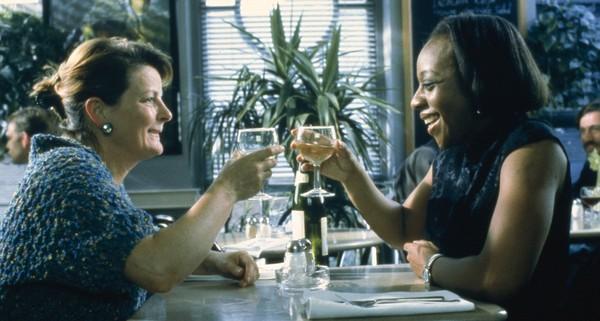
“You gotta laugh, ain’t ya sweetheart? Else you’d cry.” This observation from working-class Londoner Cynthia Rose Purley (Brenda Blethyn) is a perfect summary of the tone running through Mike Leigh’s Palme d’Or-winning melodramatic masterpiece. A slice-of-life portrayal of broken individuals navigating the complexity of their familial ties, Secrets & Lies perfectly captures the quiet intensity of ordinary suffering. Both comic and tragic, uplifting and heartbreaking, Secrets & Lies is a richly humanistic film.
The film begins with a funeral for the mum of ophthalmologist Hortense (Marianne Jean-Baptiste), a young Black woman silently enduring the grief of such loss. An adoptee, Hortense decides to embark on a journey to find her birth mother, who, as it turns out, is the aforementioned Cynthia. Hortense and Cynthia are from two completely different worlds: Black and white, wealthy and poor, educated and blue collar. What’s more, Cynthia’s daughter, Roxanne (Claire Rushbrook) knows nothing about Hortense’s existence, and Cynthia initially intends to keep things hidden.
Parallel to this undisclosed mother-daughter reunion is the story of Cynthia’s younger brother, Maurice (Timothy Spall), a successful photographer who has his own familial troubles at home. His wife, Monica (Phyllis Logan), initially comes across as uptight and selfish, and the marriage appears to be in jeopardy. But there is more happening in between Maurice and Monica than meets the eye.
Where the above scenario could have made for a mawkish or overly sentimental melodrama, Leigh’s script and direction are so tight and sincere that it makes for a profoundly affecting cinematic experience. Every single performance is pitch perfect, every spoken line rings true, and every relationship feels authentic. You can tell that Leigh and the camera truly love every single one of these characters, and so we fall in love with them as well. In a lengthy mid-point scene where Cynthia and Hortense first meet, they sit shoulder-to-shoulder in a café. The camera remains stationary and fixed on these women throughout the long take as Blethyn and Jean-Baptiste offer one of the greatest cinematic conversation scenes we will ever witness.
In the montage scenes with Maurice’s photography business, we see glimpses of anonymous characters getting their portrait taken. Cinematographer Dick Pope situates us as the audience from the point-of-view of Maurice’s camera lens, as if the people in the studio were looking right at us, the invisible audience. These scenes give us only small (literal) snapshots of these people’s lives; there are hints of joy and pain, love and anger. But we are never fully made privy to what’s happening beyond the frame, outside of the camera lens. What if we could follow these people out of the studio and listen to more of their stories, their hopes and dreams and fears? In this way, Secrets & Lies is the cinematic answer to this desire these montage scenes create within us: we are allowed, through the miracle of cinema, to enter into the intimate and sacred moments of human beings’ lives and relationships beyond the snapshot. What makes this a miracle is that the cinematic apparatus is not invasive, but rather a generator of empathy.
“Secrets and lies! We’re all in pain! Why can’t we share our pain?” cries Maurice in a climactic moment of revelation. Through the power of cinema, Secrets & Lies shares the pain of Cynthia, Maurice, Hortense, Monica, and Roxanne, reminding us that we are never truly alone. Indeed, this extraordinary work of fiction suggests that the truth can set us free.
—Joel Mayward (Cinemayward.com)
- Directed by: Mike Leigh
- Produced by: Simon Channing Williams
- Written by: Mike Leigh
- Music by: Andrew Dickson
- Cinematography by: Dick Pope
- Editing by: Jon Gregory
- Release Date: 1996
- Running Time: 136
- Language: English
Arts & Faith Lists:
]2004 Top 100 — Unranked List
2006 Top 100 — #50
2020 Top 100 — #42